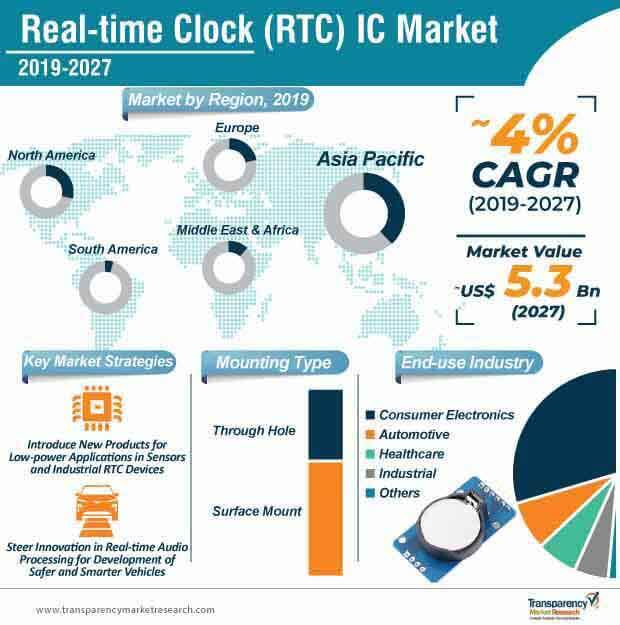
There is growing demand for real-time technology in the consumer electronics and automotive sectors. Likewise, compact real-time clock modules are gaining widespread application in a range of products that require clock functions. Companies in the real-time clock IC market are increasing focus on the development of small electronics and factory automation equipment. For instance, in October 2019, Seiko Epson Corporation – a leading Japanese electronics company, announced the launch of two new real-time clock modules under its product portfolio.
Companies in the real-time clock IC market are focusing on increased volume production during the forecast period. This is evident, since the production of real-time clock IC components is projected to reach an output of ~5.4 billion units by the end of 2027. Stakeholders in the industrial electronics value chain are benefitting from the time-stamp function of newly-introduced real-time clock modules. This new function is being widely incorporated in equipment that needs time of day information to be logged in and stored. This trend has also helped in the reduction of the equipment’s physical and environmental footprint.

Request a sample to get extensive insights into the Real-time Clock (RTC) IC Market
Introduction of New Ultra-low Power RTC Components Supports Development of Industrial Electronics
Manufacturers in the RTC IC market are increasing production capabilities to develop new products that cater to low-power applications. For instance, in June 2019, Cymbet Corporation – a supplier of thin-film and solid-state storage devices, announced the launch of next generation real-time clock IC products with power management and power switching functions.
Ultra-low power RTC components are becoming increasingly mainstream in many consumer electronics. As such, consumer electronics are anticipated to dominate the real-time clock IC market throughout the forecast period, with a revenue prediction of ~US$ 3.2 billion by 2027. Manufacturers are increasing the application of low-power RTC components in battery-less sensors and wearable sensors. They are increasing production capabilities to meet the needs of stakeholders in the industrial electronics value chain.
Power management and power switching functions are helping customers support charging voltage options in a range of backup power sources. Since the I2C (Inter-Integrated Circuit) is predicted for exponential growth in the real-time clock IC market, manufacturers are offering best-in-class operating current functions in I2C and SPI interface bus options.
To understand how our report can bring difference to your business strategy, Ask for a brochure
Tiny RTC Features Empower Designers to Develop Close-packed Wearable Devices
The tiny real-time clock feature is one of the important drivers for the real-time clock IC market. Compact RTC components are enabling designers of space-constrained systems to deliver extended battery life to devices. This trend is very prominent for medical monitors and portable terminals. Companies in the real-time clock IC market are increasing production capabilities in compact RTC components that eliminate the need for central microcontrollers for timekeeping.
Microcontrollers waste battery life, especially when small batteries power the system. Hence, companies in the real-time clock IC landscape are increasing production expertise in industry-standard power-management circuitry to provide timekeeping with extended battery life. Also, ultra-small wafer-size components significantly reduce the overall design size of wearable systems. Companies in the real-time clock IC market are competing to develop compact external circuitry by incorporating features such as integrated load caps, power management, and trickle chargers.
Read Latest Press Release By TMR:





